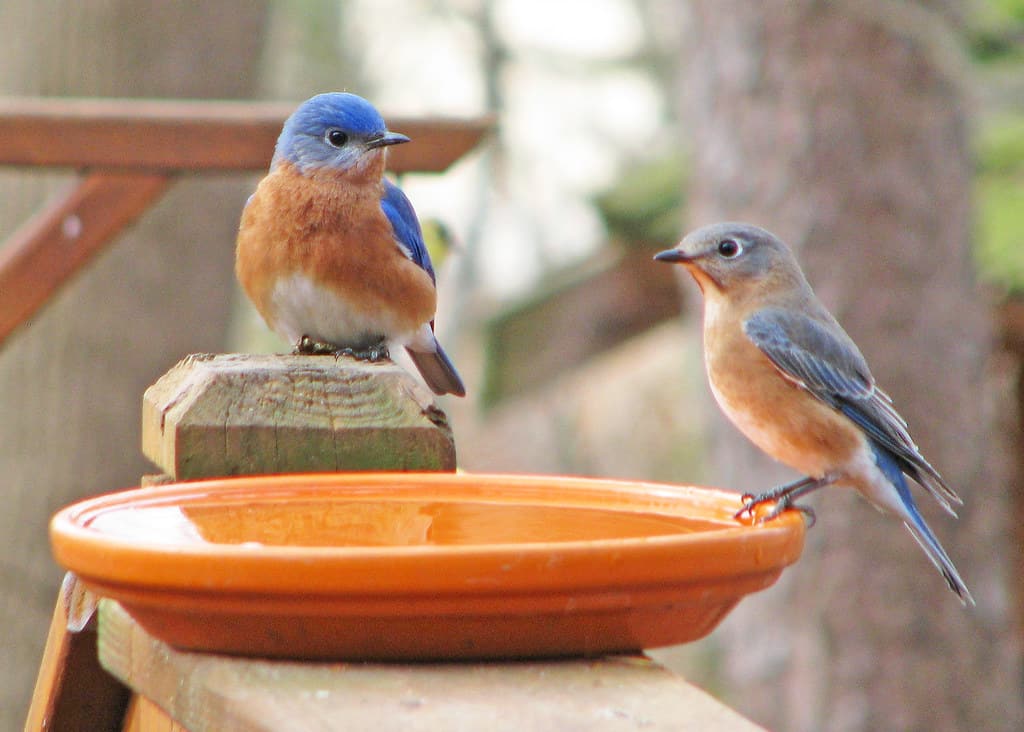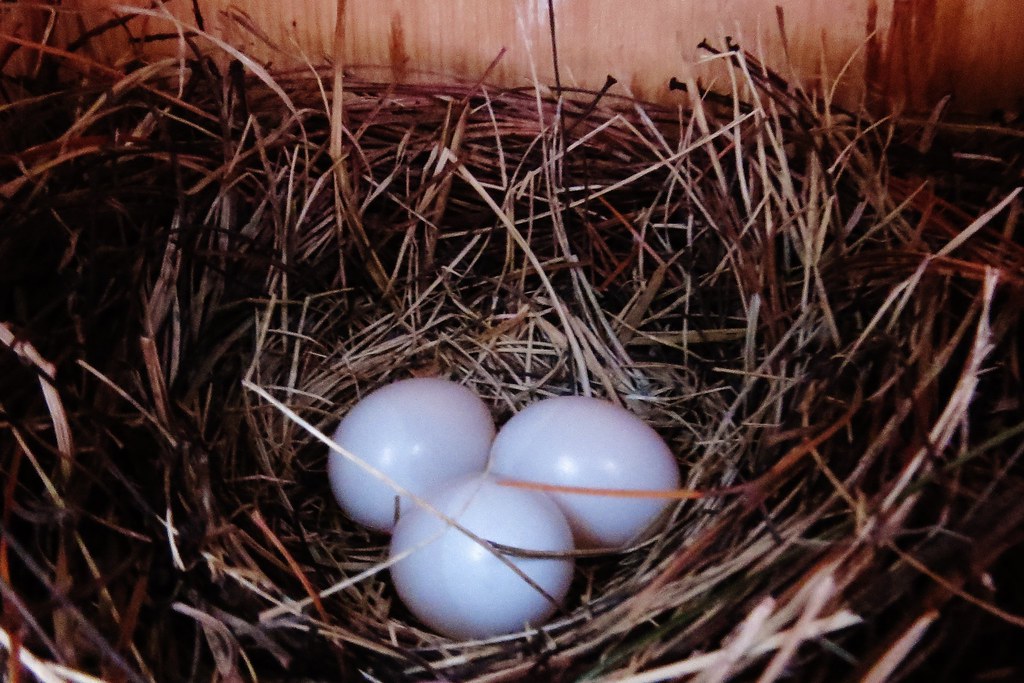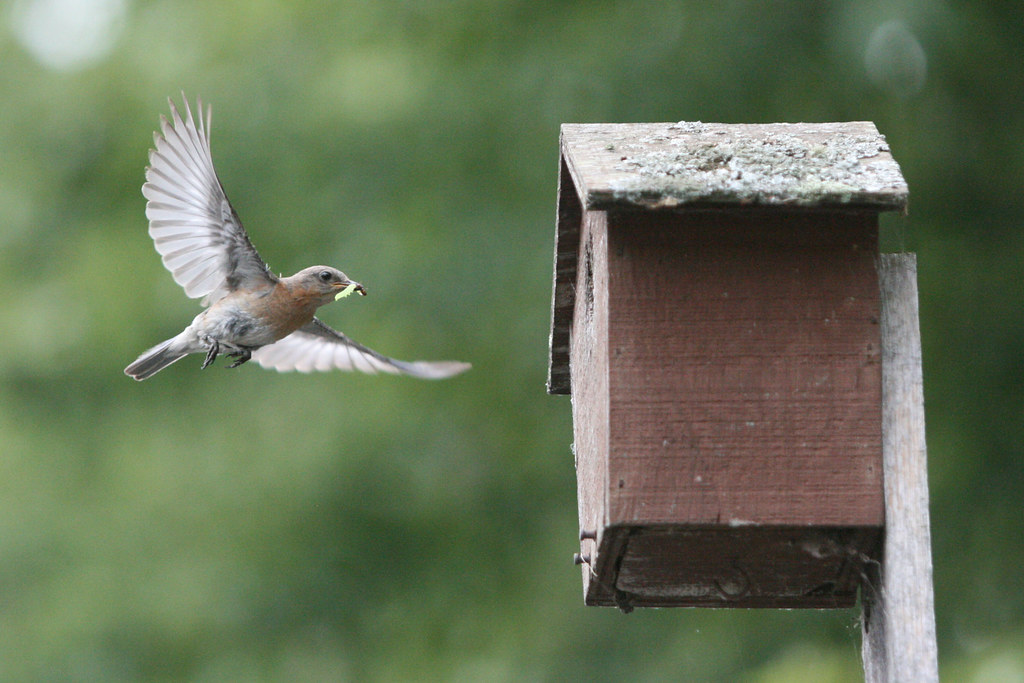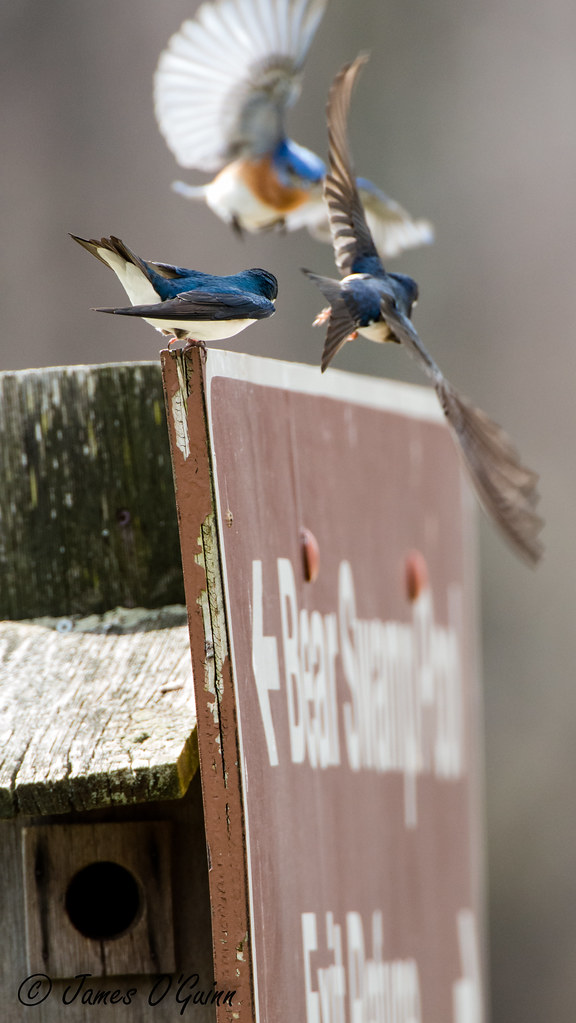
If you are a frequent bluebird watcher, you probably already know that Eastern Bluebirds are small, blue, cavity-nesting birds that are native to North America. These birds rarely come to standard bird feeders since they don’t eat many seeds, but they can be attracted to mealworm feeders and to wooden nest boxes. Since you probably already knew all these basic Eastern Bluebird facts, today I wanted to share with you seven surprising facts about Eastern Bluebirds – things that people rarely know about them.
So, without further ado, here are seven surprising facts about Eastern Bluebirds!
7 Surprising Facts About Eastern Bluebirds
1. Eastern Bluebirds are monogamous (but only sometimes)

As a general rule, bluebirds are very faithful to their mates. Close to 97% of Eastern Bluebirds choose their mate for life (source). As long as their mate is still living, most Eastern Bluebirds stay with the same mate. However, sometimes Eastern Bluebirds, both male and female, engage in “extra pair copulations,” which means that they have relations with multiple partners at the same time.
Migratory Eastern Bluebirds pair up as they gather in huge flocks before migration. If they haven’t matched up before leaving, then they will find a mate once there arrive at the nesting area. Non-migratory birds will pair up with last year’s partner once the nesting season begins, but they don’t typically spend a lot of time together outside of the breeding season.
If one or other of the birds dies, then they are quick to establish a new relationship. The job of passing on your genes must go on!
Why do Eastern Bluebirds mate with multiple partners in the same season?
Eastern Bluebirds may choose to mate with an additional partner if they suspect that their current partnership won’t produce offspring. For example, if they had a previous failed nesting attempt with their current mate, Eastern Bluebirds may choose to mate with a second partner on the side to increase their own chances of producing offspring in a given season (source). To them, it’s all about being fertile and multiplying.
2. Eastern Bluebirds lay white eggs 4-5% of the time

Photo by scrapkat1 is licensed under CC BY-ND 2.0
If you have ever snuck a peek into an Eastern Bluebird nest, you will likely have seen a little clutch of four or five bright blue eggs. Their eggs are generally a little bit lighter than “Robin’s-egg-blue.” However, bluebird eggs aren’t always blue. Eastern Bluebirds lay white eggs around 4 to 5% of the time (source). In reality, these eggs aren’t quite pure white. They’re usually a very pale blue or a light shade of pink.
Is it normal for bluebirds to lay white eggs?
If you see white eggs in your Eastern Bluebird nest, it’s nothing to be alarmed about. It’s normal for 4-5% of female bluebirds to lay white eggs. The white eggs will produce healthy bluebird chicks just like blue eggs. Also, if a particular female bluebird lays white eggs, that means she will always lay white eggs. So, if you see white bluebird eggs in your nest box two years in a row, that’s a good indicator that the same bluebird pair has returned from the previous year.
Why do bluebirds lay white eggs?
There are a number of theories as to why bluebirds occasionally lay white eggs. These include a genetic explanation, where the bluebird female carries a “white egg gene.” Then there’s a physiological explanation which says that the gland that produces the blue coloration in most bluebird eggs can become infected or damaged. When this happens, apparently, the result is white eggs. Whatever the reason is, you have no reason to worry about white eggs. It’s very normal for the occasional Eastern Bluebird to lay white eggs.
One interesting thing to note is this. If you see both blue and white eggs in a single nest, it means that more than one female bluebird has laid eggs in that nest. This only happens rarely, and it may even mean that two females are actively incubating the eggs (source).
3. Eastern Bluebirds occasionally interbreed with Mountain Bluebirds
There are three different species of Bluebirds in the US. The Western Bluebird lives mostly west of the Rockies, the Mountain Bluebird is also found west of the Rockies, but at higher elevations, and then the Eastern Bluebird is found east of the Rockies and throughout the whole eastern United States. Click here to read my article comparing the three different species of bluebirds.
While the three species of bluebirds typically only breed within their own species, there are well documented cases of Eastern and Mountain Bluebirds (which have adjoining ranges) meeting, mingling, and successfully mating (source).
Video: Hybrid Eastern/Mountain Bluebirds
Below is a video of a hybrid Eastern/Mountain bluebird pair caught on camera in the American Midwest. The pair is an Eastern Bluebird male and a Mountain Bluebird female, who had apparently travelled all the way east to the state of Wisconsin for the spring.
Mountain Bluebirds are adventurous colonizers and will spread into new territories as they become available. Usually, they move into spots where they expect better nesting opportunities, such as areas which have suffered forest fires or areas with less competition for nesting sites.
When Eastern Bluebirds encounter Mountain Bluebirds within their range, the will consider them for potential mates, particularly if their options for same-species mates are limited. The resulting “hybrid” bluebird pairs can and do produce fertile offspring.
4. Eastern Bluebirds are the largest species of bluebird, not the smallest

Since Eastern Bluebirds require a smaller nest box entrance hole than other species of bluebirds, people often consider them to be the smallest bluebirds species. However, since an adult Eastern Bluebird can weigh up to 32 grams, they are actually the heaviest of all three bluebird species. So, while their smaller wingspans allow Eastern Bluebirds to use smaller nest boxes and entrance holes, their weight technically classifies them as the largest bluebird species.
See the data points below for how Eastern Bluebirds compare in weight and wingspan length to Western and Mountain Bluebirds.
Eastern Bluebirds
Weight: 28 -32 grams
Wingspan: 9.8-12.6 inches
Western Bluebirds
Weight: 24 – 31g
Wingspan: 11.4-13.4 inches
Mountain Bluebirds
Weight: 30g
Wingspan: 11.0-14.2 inches
Data Source: Cornell Lab of Ornithology (link)
5. Eastern Bluebirds often show aggression toward other bluebirds of the same sex

Bluebirds have a reputation for being peaceful, gentle creatures, but they can actually show quite a bit of aggression, especially toward other bluebirds of the same sex. Eastern Bluebird males aggressively fight off other males to defend their nesting territory, and females do the same to other females (source).
Eastern Bluebirds often fight with other bluebirds of the same sex to defend their nesting site or to compete for the same mate. Some bluebirds tend to be more aggressive than others, and usually the aggression is most strong during breeding and nesting season when competition is most important for the survival of their young.
6. Eastern Bluebirds can attack (and even kill) Tree Swallows when competing for nest boxes

Photo by General Toner is licensed under CC BY-NC-ND 2.0
You hear a lot about bluebirds fighting with House Sparrows for nesting sites. As House Sparrows are definitely the more aggressive of the two species, many times they end up beating bluebirds in head to head battles. However, it might surprise you that Eastern Bluebirds can fight pretty ferociously with Tree Swallows. And, since Tree Swallows are the smaller and weaker of the two species, bluebirds usually win, and sometimes it’s deadly.
As a general rule, Eastern Bluebirds are larger and more aggressive than Tree Swallows. While not common, bluebirds will have no hesitation in fighting Tree Swallows, even to the death, to claim a desired nesting site (source). The two species will fight especially hard if both pairs feel attached to a certain nest box.
Is there a solution to Eastern Bluebird and Tree Swallow competition?
If you are interested in attracting both Bluebirds and Tree Swallows to your property, you will need to provide a way for them to live harmoniously in the same territory. The best method to date is the idea of “pairing” bluebird and swallow nest boxes together. In a nutshell, this means pairing two nest boxes about 10 feet apart. In theory, bluebirds will claim one and they will leave the other nest box to the swallows.
With two available nest boxes in the same space, both species can tolerate being close to one another. Once they sort out which pair gets which box, you get to enjoy watching them both!
Now, on the the seventh and final surprising fact about Eastern Bluebirds. This one might shock you!
7. Eastern Bluebirds have never actually been endangered

Despite popular belief to the contrary, the Eastern Bluebird is not a threatened species, and it has never been listed as “endangered.” In 2021, it was estimated that the Eastern Bluebird population numbered at least 23,000,000. This population size is highly viable for the continuation of the species. Even though the Eastern Bluebird populations saw a decline in the 20th century, at no point were bluebirds actually considered endangered.
Why do people think bluebirds were endangered?
In the early 20th century, many scientists and birdwatchers became concerned because of the decline in the Eastern Bluebird population. This population decline was mostly due to competition from non-native House Sparrows and human urbanization making nesting sites less available. Western and Mountain Bluebirds suffered similar population declines as well.
As a reaction to this, many called for conservation efforts that focused on saving the bluebirds by erecting bluebird nest boxes and monitoring them closely. These efforts worked! The Eastern Bluebird population is now extremely healthy and they are listed as a species of “least concern” by the IUCN (source).
Even though bluebirds were never actually endangered, they do rely heavily today on human-made nest boxes for nesting sites. If you have the opportunity, I highly recommend putting up your own bluebird nest box to attract them to your yard.
Conclusion: Surprising Facts About Eastern Bluebirds
There you go! Those are my seven surprising facts about Eastern Bluebirds.
If you want to attract bluebirds to your own backyard, click here to read my article called How to Attract Bluebirds. Then check out my Recommended Tools page here to see the bluebird houses, feeders, and other bluebird related tools that I recommend.

